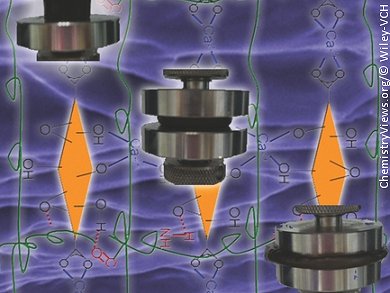Polymer hydrogels show potential as scaffolding materials for various biological applications. However, applications of the conventional covalent-crosslink hydrogels are limited as they contain irregular crosslinking points and a wide range of chain lengths, thus resulting in brittleness, low-stretch properties, and poor mechanical strength. Therefore, there is increasing interest in the development of novel hydrogels, such as double-network polymer hydrogels and nanocomposite hydrogels. In double-network polymer hydrogels the synergistic effects of the two networks result in hydrogels with improved mechanical behavior.
Huai-Ping Cong, Shu-Hong Yu, and Ping Wang, University of Science and Technology of China and Hefei University of Technology, Hefei, China, have combined the characteristics of double-network and nanocomposite hydrogels in elastic graphene oxide (GO)/polyacrylamide (PAM) hydrogels. These hydrogels were synthesized by a one-pot polymerization of acrylamide monomers in a mixture of Ca(NO3)2 and a GO dispersion with N,N-methylenebisacrylamide and ammonium persulfate as the crosslinker and initiator, respectively.
Hydrogen bonds are formed between a Ca2+ coordination-induced GO nanosheet network and a covalently crosslinked PAM network to give an integrated and stable hydrogel network. These three interactions work synergistically; the PAM network stabilizes the deformations of the gel, while the GO network reduces the crack energy through unzipping of the network of ionic crosslinks, and the original state of the hydrogel is maintained by the hydrogen bonding. Thus, the resulting hybrid hydrogel displayed good strength and elasticity.
Owing to their strength and flexibility, these materials could expand the applications of hydrogels in the biomedical field.
- Highly Elastic and Superstretchable Graphene Oxide/Polyacrylamide Hydrogels,
Huai-Ping Cong, Ping Wang, Shu-Hong Yu,
Small 2013.
DOI: 10.1002/smll.201301591




